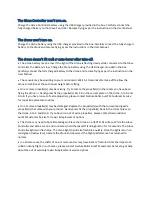
PRISM FLIGHT MANUAL
44
PRISM maneuvers by means of variable propulsion through its four to eight U8ii motors.
Each motor is equipped with a 28-inch folding propeller, and motors are arranged in
alternating clockwise (CW) and counter-clockwise (CCW) configuration to cancel rotational
inertia and provide the maximum-possible stability in flight.
The T-Motor U8ii motor system operates on a 48-volt power supply to provide a maximum
thrust of 7.3 kg (16 pounds) per rotor at sea level, for a combined thrust of 29.2 kg (64.4
pounds) in the quadcopter configuration, or approximately 58.4 kg (128.7 pounds) in the
coaxial X8 configuration (this value is approximate due to the reduced efficiency of thrust
when motors are paired in a coaxial configuration). The X-Carbon polymer (quadcopter) or
T-motor P&G Series carbon-fiber (coaxial X8) fixed-pitch propellers are 28 inches from tip to
tip when unfolded.
Propellers are mounted to the T-motor U8ii motors, a pancake-style electronic brushless
designed for efficiency and intelligence. Each motor weighs 200 grams (7.1 ounces) and
has a KV of 85 RPM per volt.
The Watts Innovations PRISM’s unique propulsion design allows users to fly the aircraft
in either a quadcopter configuration, or in an Coaxial X8 configuration with two motors
mounted coaxially to each boom.
PRISM is shipped with a propulsion system that is determined by the user (generally either
a Quadcopter or Coaxial X8). Each is hard-coded and tuned for optimal performance at a
specific mounting location about the central airframe: Front Right, Front Left, Back Right
and Back Left. The mounting locations cannot be interchanged, and incorrectly-mounted
propulsion booms will cause the flight controller to fail a pre-arm systems check.
The propulsion system can be reconfigured by removing two bolts at the attachment point
of each boom.
Removing a Propulsion System:
• Simply remove the two shouldered bolts with a M3 hex driver.
• Repeat for each arm
7.5 PROPULSION SYSTEM
7.5.1 WATTS INNOVATIONS PROPULSION-AGNOSTIC SYSTEM
(PROPULSION ID)
Summary of Contents for PRISM R.P.A.S.
Page 3: ...PRISM FLIGHT MANUAL 3 INTENTIONALLY LEFT BLANK...
Page 5: ...PRISM FLIGHT MANUAL 5 INTENTIONALLY LEFT BLANK...
Page 7: ...PRISM FLIGHT MANUAL 7 INTENTIONALLY LEFT BLANK...
Page 18: ...PRISM FLIGHT MANUAL 18 Figures 5 6 PRISM PAYLOAD AND FLIGHT TIME CALCULATIONS...
Page 21: ...PRISM FLIGHT MANUAL 21 Figure 7 RPA ORIENTATION DURING TAKEOFF LANDING...
Page 47: ...PRISM FLIGHT MANUAL 47 Figure 8 PRISM POWER CIRCUIT DIAGRAM...
Page 53: ...PRISM FLIGHT MANUAL 53...
Page 54: ...PRISM FLIGHT MANUAL 54...
Page 57: ...PRISM FLIGHT MANUAL 57 Figure 14 20 WATTSQGC APPLICATION SETTINGS GENERAL...
Page 67: ...PRISM FLIGHT MANUAL 67 Figure 31 COMPASS CALIBRATION SCREEN...
Page 81: ...PRISM FLIGHT MANUAL 81 Figure 46 47 USER SELECTABLE TELEMETRY VALUES FOR HUD...
Page 84: ...PRISM FLIGHT MANUAL 84 Figure 50 51 WATTSQGC PRE FLIGHT CHECKLIST...
Page 103: ...PRISM FLIGHT MANUAL 103 Assembled battery pack Smaller battery assembly Assembled battery pack...
Page 106: ...PRISM FLIGHT MANUAL 106 Battery Packs Top Mounted Battery Packs Bottom Mounted...
Page 136: ...PRISM FLIGHT MANUAL 136 SUPPLEMENT 1...
Page 137: ...PRISM FLIGHT MANUAL 137 SUPPLEMENT 2A...
Page 138: ...PRISM FLIGHT MANUAL 138 SUPPLEMENT 2B...
Page 139: ...PRISM FLIGHT MANUAL 139 SUPPLEMENT 3...








































